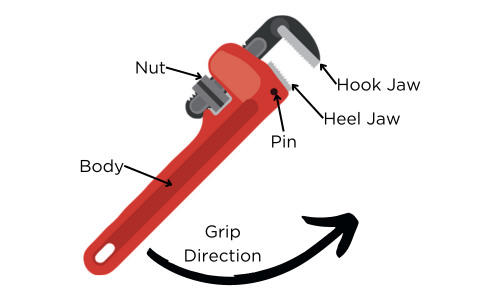Pipe Wrench
Anatomy of a Pipe Wrench

What is a Pipe Wrench?
Who would use a Pipe Wrench?
A pipe wrench is typically used by:
- Plumbers: For installing, repairing, and maintaining piping systems.
- Steamfitters, Pipefitters, Welders & Fabricators: Working on high-pressure piping systems in industrial, commercial, and residential settings.
- Gas Fitters: For assembling and maintaining natural gas lines.
- Utility Workers: Especially those involved in water and sewage services, for managing and repairing mains pipes.
- HVAC Technicians: In the installation and repair of heating, ventilation, and air conditioning systems that involve piping.
- Maintenance Workers: For general upkeep tasks that involve plumbing in facilities like schools, hospitals, and office buildings.
- DIY Enthusiasts: Homeowners doing their own plumbing repairs or projects.
- Fire Sprinkler Installers: For fitting and maintaining fire suppression piping systems.
- Oil and Gas Workers: For assembling and maintaining pipes used in oil and gas extraction and processing.
Safety Precautions with Pipe Wrenches!
When using a pipe wrench, remember to:
- Wear Gloves and Glasses: Protect your hands and eyes.
- Check the Wrench: Make sure it’s not damaged before using.
- Choose the Right Size: Pick a wrench that fits the pipe well.
- Pull, Don’t Push: It’s safer to pull the wrench towards you.
- Don’t Force It: Use only the needed force to avoid breaking anything.
- Position Correctly: Make sure the wrench grips the pipe properly.
- Keep the Area Tidy: Clear any clutter to prevent trips and falls.
- Don’t Use Extensions: Don’t make the wrench handle longer for extra force.
- Secure the Pipe: Hold the pipe steady while you work.
- Use as Intended: Pipe wrenches are for round pipes, not nuts or bolts.
ToolFinder Recommends

RIDGID 31005 Model 8 Heavy-Duty Straight Pipe Wrench, 8-inch Plumbing Wrench, Small, Red
Sometimes it’s nice to have a smaller pipe wrench available for small spaces. This particular wrench is a nice one to keep in the portable toolbox, as well! RIDGID 31005 Model 8 Heavy-Duty Straight Pipe Wrench, 8-inch Plumbing Wrench, Small, Red

RIDGID 31015 Heavy-Duty Straight Pipe Wrench, 12" Sturdy Plumbing Wrench with Self Cleaning Threads and Hook Jaws, Red, Small
For a mid-size wrench that’s going to allow for additional torque but still fairly simple to handle, check out the RIDGID 31015 Heavy-Duty Straight Pipe Wrench, 12″ Sturdy Plumbing Wrench with Self Cleaning Threads and Hook Jaws, Red, Small

Milwaukee 48-22-7314 CHEATER Adaptable Pipe Wrench
When you need a wrench that can give you that extra force when needed, but can fit in some smaller spaces otherwise – it might be a good decision. This wrench is referred to as a “Cheater” Pipe Wrench. ultimately, you could put a pipe on the handle of another wrench and get a similar effect, but this one has a direct connection with a bigger handle when you need it, or you could even use a longer pipe! Just be careful when and how you use something like this. Milwaukee 48-22-7314 CHEATER Adaptable Pipe Wrench